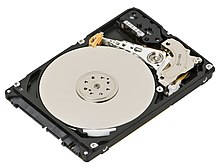ST3000DM001
SATA 3 | |
| Speed | 7200 RPM |
|---|---|
The ST3000DM001 is a
Specifications
The ST3000DM001 uses three 1 TB
Initial reception

Anand Lal Shimpi of AnandTech noted that the ST3000DM001 is "a bit faster in sequential performance than the old Barracuda XT, at lower power consumption" and that "Seagate appears to have optimized the drive's behavior for lower power rather than peak performance". He said he was "personally OK" with the lower performance under heavy loads as long as the drive is used together with a solid-state drive (SSD) in a system.[2]
Failures
Observations at Backblaze
Backblaze, a remote backup service company, observed that its ST3000DM001 drives have failed at rates far higher than the average of other hard drives.[1] Only 251 of the 4,190 ST3000DM001 hard drives placed in service in 2012 were still in service as of 31 March 2015.[3]
According to Backblaze, the company switched to Seagate 3 TB hard drives after the 2011 Thailand floods disrupted the supply of hard drives and increased their prices by 200–300%. Backblaze, which normally used HGST 3 TB hard drives, was only able to find Seagate 3 TB drives in "decent quantity". Backblaze noted that the failure rates of the ST3000DM001 did not follow a bathtub curve typically followed by hard disk drive failure rates, instead having 2.7% failing in 2012, 5.4% failing in 2013, and 47.2% failing in 2014. Other 3 TB hard drives that Backblaze placed in service in 2012, which was operated in a similar environment as the Seagate drives, did not show signs of increased failure.[3]
Joel Hruska of ExtremeTech noted that Backblaze was unable to explain the high failure rates of the ST3000DM001 compared to other products. Hruska pointed out that Seagate cut the warranty for these drives, along with most other hard disk drive manufacturers, from three years to one year in 2012. Hruska provided supplier-change or part substitution, shipping of substandard hardware to increase profits, and Backblaze's use of consumer hard drives in an enterprise environment as possible explanations.[1] Paul Alcorn of Tom's Hardware pointed out that of the 3 TB hard disk drive models that were in service with Backblaze, the ST3000DM001 was the only drive without a rotational vibration sensor that counteracts excessive vibration in heavy-usage cases.[4]
Cause

In July 2021,
Class action
In 2016, Seagate faced a class action over the failure rates of its ST3000DM001 3 TB drives.[4][6][7][8] Law firm Hagens Berman filed the lawsuit on 1 February in the United States District Court for the Northern District of California, and primarily cited reliability data provided by Backblaze. The lawsuit also pointed to user reviews of the hard disk drive on Newegg, which totaled more than 700 reviews with 2 or fewer stars.[6]
The lawsuit lists Christopher Nelson, who purchased a Seagate Backup Plus 3 TB drive and a Seagate Barracuda 3 TB hard disk drive in October 2011, as its plaintiff. Both products subsequently failed, and the lawsuit contended that Seagate replaced them with inherently faulty products.[4]
On 15 June 2018, Judge Joseph Spero ruled that the class action plaintiffs must separate into multiple classes, as there was too much variability in failure rates to combine all claims into a single class.[9][10] In 2019, the plaintiffs were denied class certification a second time.[11]
References
- ^ a b c Hruska, Joel (16 April 2015). "Backblaze pulls 3TB Seagate HDDs from service, details post-mortem failure rates". ExtremeTech. Archived from the original on 27 August 2016. Retrieved 27 August 2016.
- ^ a b Shimpi, Anand Lal (2 November 2011). "Seagate's New Barracuda 3TB (ST3000DM001) Review". AnandTech. Archived from the original on 5 September 2016. Retrieved 27 August 2016.
- ^ a b Klein, Andy (15 April 2015). "CSI: Backblaze – Dissecting 3TB Drive Failure". Backblaze. Archived from the original on 27 August 2016. Retrieved 27 August 2016.
- ^ a b c d Alcorn, Paul (2 February 2016). "Class-Action Lawsuit Against Seagate Built On Questionable Backblaze Reliability Report". Tom's Hardware. Archived from the original on 12 July 2021. Retrieved 27 August 2016.
- ^ Miller, Chance (8 July 2021). "Experts warn of drive failures impacting users of Apple's AirPort Time Capsules". 9to5Mac. Retrieved 13 July 2021.
- ^ a b Newman, Jared (2 February 2016). "Seagate slapped with a class action lawsuit over hard drive failure rates". PC World. Archived from the original on 29 August 2016. Retrieved 27 August 2016.
- ^ a b Carey, Gabe (1 February 2016). "Reliability problems open Seagate up to class-action lawsuit over 3TB hard drives". Digital Trends. Archived from the original on 17 August 2016. Retrieved 27 August 2016.
- ^ a b Ferreira, Bruno. "Seagate hit with class-action lawsuit over 3TB drive failures". The Tech Report. Archived from the original on 27 August 2016. Retrieved 27 August 2016.
- ^ "Seagate Buyers Must Carve Up Class Cert. Bid, Judge Says". Law360. Archived from the original on 12 July 2021. Retrieved 22 April 2020.
- ^ Sortor, Emily (22 June 2018). "Seagate Hard Drive MDL Must Divide Into Multiple Classes, Judge Rules". Top Class Actions. Archived from the original on 19 March 2021. Retrieved 22 April 2020.
- ^ "Seagate Hard Drive Buyers Lose 2nd Class Cert. Bid". Law360. Archived from the original on 12 July 2021. Retrieved 22 April 2020.
External links
- "Product Manual - Seagate Desktop HDD" (PDF). January 2015.
